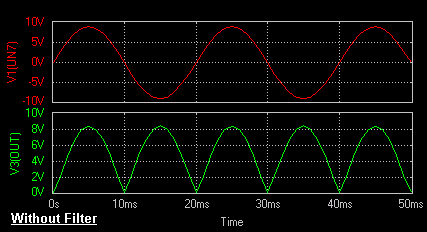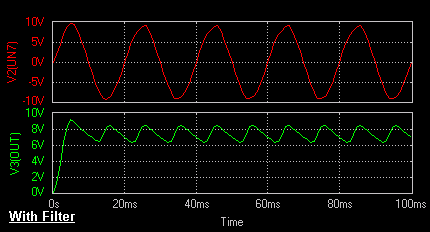The average voltage or the dc voltage available across the load
resistance is |

|

|

|
RMS value of the voltage at the load resistance is |
 |
 |
Efficiency, h
is the ratio of dc output power to ac input power |
The maximum efficiency of a Full Wave Rectifier is 81.2%. |
Transformer Utilization Factor
|
Transformer Utilization Factor, TUF can be used to determine the rating
of a transformer secondary. It is determined by considering the primary and the secondary
winding separately and it gives a value of
0.693.
|
Form factor is defined as the ratio of the rms value of the output
voltage to the average value of the output voltage. |


Peak factor is defined as the ratio of the peak value of the output
voltage to the rms value of the output voltage. |

Peak inverse voltage for Full Wave Rectifier is 2Vm because
the entire secondary voltage appears across the non-conducting diode. This concludes the explanation of the various factors associated with
Full Wave Rectifier.
Rectifier with Filter
The output of the Full Wave
Rectifier contains both ac and dc components. A majority of the
applications, which cannot tolerate a high value ripple, necessitates further processing of the rectified
output. The undesirable ac components i.e. the ripple, can be minimized
using filters.
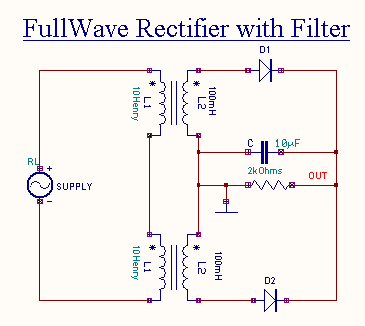
The output of the rectifier is fed as input to
the filter. The output of the filter is not a perfect dc, but it also contains
small ac components.
Some important filters are
- Inductor Filter
- Capacitor Filter
- LC Filter
- CLC or p Filter
Inductor Filter
The figure shows an inductor filter.When the output of the rectifier passes through an inductor, it blocks the ac component and
allows only the dc component to reach the load.
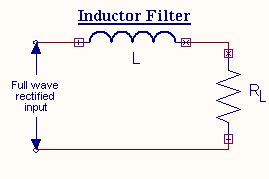
Ripple factor of the inductor filter is given by
 .
.
The above equation shows that ripple will decrease when L is increased
and RL
is decreased.
Thus the inductor filter is more effective only
when the load current is high (small RL). The larger
value of the inductor can reduce the ripple and at the same time the
output dc voltage will be lowered as the inductor has a higher dc
resistance.
The operation of the inductor filter depends on its
property to oppose any change of current passing through it. To analyze
this filter for full wave,
the
Fourier series can be written as 
The dc component is 
Assuming the third and higher terms contribute little output, the
output voltage is

The diode, choke and transformer resistances can be neglected since
they are very small compared with RL. Therefore the dc component of current 
The impedance of series combination of L and RL at 2w is

Therefore for the ac component,

Therefore, the resulting current i is given by,

The ripple factor which can be defined as the ratio of the rms value of
the ripple to the dc value of the wave, is

If 
 , then a simplified expression for g is
, then a simplified expression for g is

In case, the load resistance is infinity i.e., the output is an open
circuit, then the ripple factor is  . This is slightly less than the value of 0.482. The difference being
attributable to the omission of higher harmonics as mentioned. It is clear
that the inductor filter should only be used where RL is consistently small.
. This is slightly less than the value of 0.482. The difference being
attributable to the omission of higher harmonics as mentioned. It is clear
that the inductor filter should only be used where RL is consistently small.
Capacitor Filter
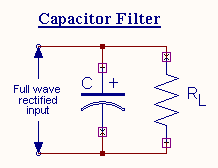
A capacitor filter connected directly across the load is shown above. The
property of a capacitor is that it allows ac component and blocks dc component. The operation of the capacitor filter
is to short the ripple to ground but leave the dc to appear at output when
it is connected across the pulsating dc voltage.
During the positive half cycle, the capacitor charges upto the peak
vale of the transformer secondary voltage, Vm
and will try to maintain this
value as the full wave input drops to zero. Capacitor will discharge through RL slowly until the transformer secondary
voltage again increase to a value greater than the capacitor voltage. The
diode conducts for a period, which depends on the capacitor voltage. The
diode will conduct when the transformer secondary voltage becomes more
than the diode voltage. This is called the cut in voltage. The diode stops
conducting when the transformer voltage becomes less than the
diode voltage. This is called cut out voltage.
Referring to the figure below, with slight approximation the ripple voltage
can be assumed as triangular. From the cut-in point to the cut-out point, whatever charge the capacitor acquires
is equal to the charge the capacitor has lost during the period of
non-conduction, i.e., from cut-out point to the next cut-in point.
The charge it has acquired
The charge it has lost
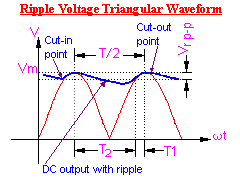

If the value of the capacitor is fairly large, or the value of the load
resistance is very large, then it can be assumed that the time T2
is equal to half the periodic time of the waveform.

From the above assumptions, the ripple waveform will be triangular and
its rms value is given by




The ripple may be decreased by increasing C or RL
(both) with a resulting increase in the dc. output voltage.
LC Filter
The ripple factor is directly proportional to the
load resistance RL in the inductor filter and inversely proportional to RL in the capacitor
filter. Therefore if these two filters are combined as LC filter or L
section filter as shown in figure the ripple factor will be independent of RL.
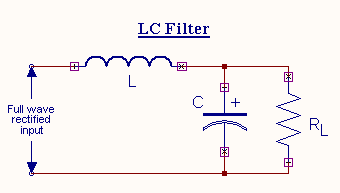
If the value of inductance is increased it will increase
the time of conduction. At some critical value of inductance, one diode, either D1 or
D2 will always conducting.
From Fourier series, the output voltage can be expressed as

The dc output voltage, 

The ripple factor 

CLC or p Filter
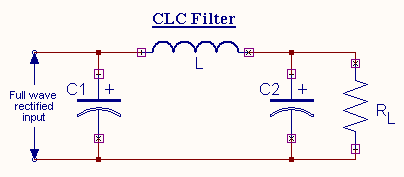
The above figure shows CLC or p
type filter, which basically consists of
a capacitor filter, followed by LC section. This filter offers a fairly smooth output and is characterized by highly peaked
diode currents and poor regulation. As in L section filter the analysis is
obtained as follows.

Procedure
EDWinXP-> Schematic Editor: The circuit
diagram is drawn by loading components from the library. Wiring and proper
net assignment has been made. The values are assigned for relevant components.
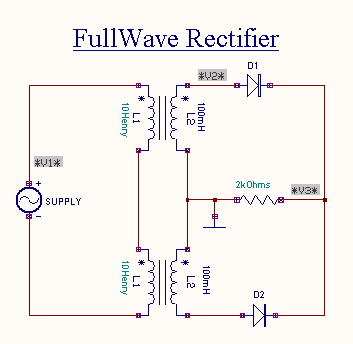
EDWinXP -> Mixed Mode Simulator: The circuit is preprocessed. The test points and
waveform markers are placed in input and output of the circuit. GND net is set as
reference net. The Transient Analysis parameters have been set. The
Transient Analysis is executed and output waveform is observed in Waveform Viewer.
Result
The output waveform for Full Wave Rectifier with filter and without
filter may be observed in the waveform viewer.
